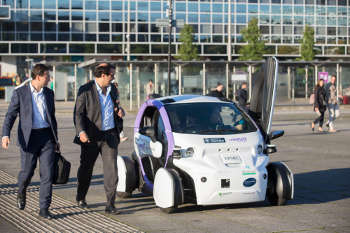Legislators and transportation regulators around the world are grappling with how to most effectively regulate autonomous vehicles (AV).
The issue that continues to raise the most questions and stall legislative developments is how to best handle liability and insurance. The UK is set to be the first country to address this issue head-on through the Vehicle Technology and Aviation Bill.
The predecessor to the Vehicle Technology and Aviation Bill was first proposed in May 2016 as the Modern Transportation Bill. After consultation, the revised Bill entered Parliament on 22 February 2017 and has quickly gone through a number of Parliamentary stages.
If approved, it expected to receive Royal Assent and could be made law within months. A key element of the bills is the incorporation of insurance requirements for driverless cars into its legislation.
As the first country to consider such provisions, this highlights the potential for the UK to be leader in the AV sector. The UK Government appears to be taking great leaps forward towards ensuring that the country remains a leader in the AV space by being the first to legislate on this matter, while recognising that it is sensible not to over-regulate at this important stage of research and development given the inadvertent barriers to delivery.
Window of Opportunity
In a speech last May, transport minister Andrew Jones stressed that the UK is faced with a 'rare window of opportunity' for innovation in the car insurance industry in the development of new insurance products and approaches.
Mr Jones also outlined that the current data upon which insurance is 'priced and sold will steadily become obsolete' as AV technology develops.

A driverless car in the 'real world' of Milton Keynes
Insurers will be able to further embrace connectivity to deliver ever more specific data about individual drivers and their real risk and real time situational awareness, including in different traffic scenarios and prevailing weather conditions.
In addition, insurance rates and coverage will need to adapt due to the shift in liability from individual driver to autonomous vehicle.
The question of liability with regards to collisions involving AV is a difficult issue. What if an AV is found to have a defect, or a human passenger took control of the vehicle shortly before a collision occurred (or, vice versa, did not take control when required to do so)?
There may be black and white cases where fault clearly lies with the human or the 'computer', but there is a substantial grey area where responsibility could be argued to be fluid, which will present very difficult civil (and potentially criminal) scenarios.
Single Insurer Model
In the response to its consultation, published in January 2017, the Government noted its intention to 'extend compulsory motor insurance creating a single insurer model to protect victims where the AV crashes in automated mode'.
The Single Insurer Model will work alongside the Road Traffic Act 1988 to ensure that a motorist has insurance: (1) when they are manually driving a vehicle; and (2) when AV technology is activated or in use.
The Model will provide adequate protection for motorists, as it will provide insurance coverage when they suffer damage while the vehicle is activated in autonomous mode. In addition, an innocent victim of a collision (whether this be other motorists or those outside of vehicles entirely, e.g. pedestrians or cyclists) will also be able to claim against the insurer.
Importantly for all motorists, in an age where instances of cybercrimes are increasing in all facets of society, insurers will not be able to exclude liability if an accident occurs as a result of an AV being hacked. Insurers will only be able to exclude liability in certain specific situations, such as when a motorist has failed to install software updates when required to do so.
While an insurer will be expected to pay out for collisions involving an insured AV under the Single Insurer Model, if a manufacturer is ultimately found to be liable – for instance, if it is established that an accident was the result of a software glitch – the insurer will be able to seek recovery from the manufacturer under product liability laws and the common law of negligence.
Complex scenarios will undoubtedly remain for such nascent technology. For example, the position on ultimate liability is complicated by developments as the vehicle and its technology will not necessarily be the work of a single manufacturer but a 'consortium' of automotive and tech players in a shared environment.
Indeed, a number of high-profile partnerships have been announced over the course of the year. It is anticipated that insurers and manufacturers will work together to establish an effective protocol for handling all such claims quickly and efficiently.
The Government response points out that if manufacturers obstruct this process, insurers will be able to simply cease offering AV insurance – effectively leaving manufacturers of the AV technology in the unwelcome position whereby their products will not be able to be legally used by motorists.
Driverless cars will certainly impact the insurance industry. Insurance carriers that readily understand and properly evaluate the risks of different AV technology, through the use of powerful 'big data' analytics and other solutions, will undoubtedly be the winners in a tougher, rapidly evolving and ever changing automotive insurance market.
Simon Garbett and Helen Cain, Squire Patton Boggs
Register now for full access
Register just once to get unrestricted, real-time coverage of the issues and challenges facing UK transport and highways engineers.
Full website content includes the latest news, exclusive commentary from leading industry figures and detailed topical analysis of the highways, transportation, environment and place-shaping sectors.
Use the link below to register your details for full, free access.
Already a registered? Login